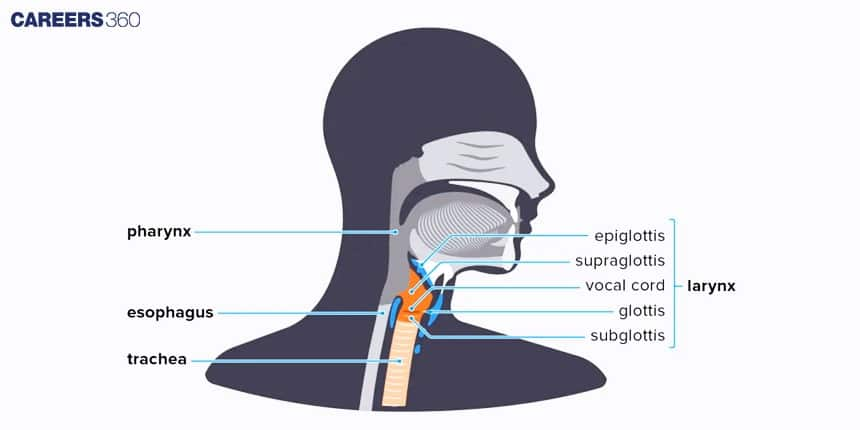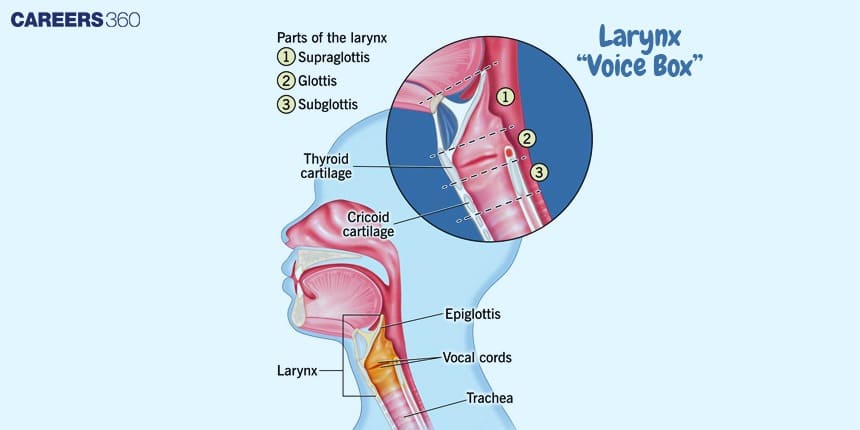Larynx: Structure, Function, Muscles, Symptoms, Causes & Treatment
The larynx, or voice box, is a vital structure in the neck responsible for sound production and airway protection. It is formed by cartilages, membranes, and muscles that regulate breathing and phonation. Understanding its anatomy and functions is essential for NEET, medical entrance exams, and human physiology studies.
This Story also Contains
- What Is The Larynx?
- Anatomy Of The Larynx
- Physiology of the Larynx
- Development and Growth of the Larynx
- Clinical Significance & Disorders
- Larynx NEET MCQs (With Answers & Explanations)

What Is The Larynx?
Located in the neck, the larynx or voice box accounts for a very critical organ of the respiratory system and vocal apparatus. From its anatomy, and physiological functioning to clinical features, this is indeed exhaustively covered by medical and biological literature.

Anatomy Of The Larynx
The anatomy of the larynx is discussed below:
Laryngeal Cartilages
The larynx is formed from four cartilages:
Thyroid cartilage: shield-shaped, Adam’s apple
Cricoid cartilage: ring below thyroid
Arytenoid cartilages: paired, anchor vocal cords
Epiglottis: leaf-like flap preventing food entry
Membranes & Ligaments
Membranes and ligaments of the vocal cords and vestibular folds (false vocal cords).
Muscles of the Larynx
The two types of muscles present in the larynx are:
Intrinsic muscles: control vocal cord tension
Extrinsic muscles: support movement during swallowing & breathing

Physiology of the Larynx
The larynx serves two primary functions:
Phonation (Voice Production)
It contains the vocal cords that undergo vibration to produce sound.
Protection of Airway
It protects the airway passage by preventing ingress of solids and liquids during deglutition and also forms a barrier to the process of breathing.
Development and Growth of the Larynx
The development and growth of the larynx is discussed below:
Fetal Development
The larynx, during fetal development, passes through important phases of development, which through its structure, determines the changes in voice during puberty.
Changes During Puberty
It is during puberty, with its changes in the hormones, that changes in vocal pitches are observed like voice deepens especially in males. The laryngeal prominence also enlarges.
Aging Effects
Just as aging is bound to affect the structural integrity of the parts to change voice quality, generally the vocal cords become weak and the pitch changes.
Clinical Significance & Disorders
The common disorders involving this structure are presented below:
Laryngitis: This is an inflammatory response mainly due to infection or overuse.
Vocal cord nodules and polyps: These are benign growths of tissue that impinge on the function of the vocal cords.
Cancer of the Larynx: This treatment should be instituted as early as possible to prevent complications.
Diagnostic Methods
Diagnostic measures can be by endoscopy, CT scans, MRI, and voice analysis to assess the condition of the larynx.
Treatments
Treatments may include conservative measures such as voice rest and medication in some cases, with operative procedures recorded for serious conditions.
Larynx NEET MCQs (With Answers & Explanations)
Important topics for NEET are:
Cartilage present in larynx and their functions
Phonation physiology
Disorders of the Larynx
Practice Questions for NEET
Q1. In man and mammals , air passes from outside into the lungs through
Nasal cavity , larynx , pharynx , trachea , bronchi , alveoli
Nasal cavity , pharynx , larynx , trachea , bronchioles , bronchi , alveoli
Nasal cavity , larynx , pharynx , trachea , bronchioles , alveoli
Nasal cavity , pharynx , larynx , trachea , bronchi , bronchioles , alveoli
Correct answer: 1) Nasal cavity , pharynx , larynx , trachea , bronchi , bronchioles , alveoli
Explanation:
Lungs: The branching network of bronchi, bronchioles, and alveoli comprise the lungs. The lungs are the primary organs of respiration, facilitating gas exchange to oxygenate the blood. The alveoli, tiny air sacs within the lungs, provide a large surface area for efficient diffusion of oxygen and carbon dioxide. The rhythmic contraction of the diaphragm and intercostal muscles aids in expanding and deflating the lungs during breathing.
Hence, the correct answer is option 4) Nasal cavity , pharynx , larynx , trachea , bronchi , bronchioles , alveoli
Q2. Which of the following options is incorrect about the larynx (sound box)?
It is a bony box
Glottis is the opening into the larynx
During swallowing of food glottis is covered by epiglottis to prevent food entry into the larynx
All of these
Correct answer: 1) It is a bony box
Explanation:
The pharynx opens through the larynx region into the trachea. The larynx is a cartilaginous box which helps in sound production and is hence called the sound box. It is situated behind the mouth and nose and joins the oesophagus (eating tube) and breathing routes (trachea [windpipe] and lungs) to the mouth (oral cavity).
Hence, the correct answer is option 1) It is a bony box.
Q3. A straight tube extending up to the mid-thoracic cavity is
Larynx
Pharynx
Trachea
Nostril
Correct answer: 3) Trachea
Explanation:
The trachea, a fundamental component of the respiratory system, is a tube extending from the larynx to the thoracic cavity, dividing into the right and left bronchi at the T4-T5 vertebral levels. It is approximately 10-12 cm long and 2-2.5 cm wide.
Structurally, the trachea is composed of C-shaped cartilage rings that are incomplete at the back, ensuring the tube remains open and uncollapsed during the respiratory process. This design also allows for flexibility near the esophagus, facilitating food passage. The trachea's interior is lined with a mucosal layer featuring ciliated pseudostratified epithelium and mucus-producing goblet cells. A submucosal layer beneath the mucosa contains connective tissue, blood vessels, and additional mucus-secreting glands. The outermost layer is the adventitia, which provides further structural support.
The trachea performs several critical functions, primarily the conduction of air to and from the lungs. Additionally, it filters incoming air, adding moisture and warmth through mucus production and the ciliated epithelium's actions. The mucociliary escalator mechanism moves mucus with trapped particles upwards, protecting the respiratory tract from inhalation of foreign substances.
Hence, the correct answer is option 3) Trachea.
Also Read:
Frequently Asked Questions (FAQs)
The larynx is the voice box responsible for phonation, which is the production of voice, together with protecting the airway during swallowing.
This system houses the thyroid, cricoid, and arytenoid cartilages, vocal cords, membranes, ligaments, and muscles.
Exhaled air causes the vocal folds to vibrate, producing sound waves, which then form the speech.
The more prevalent disorders of this organ are laryngitis, nodules or polyps on the vocal cord, and cancer of the larynx.
The diagnosis involves imaging studies and endoscopy. Treatment will, therefore, be modified based on the stage of the disease with surgical intervention, radiotherapy, and chemotherapy.